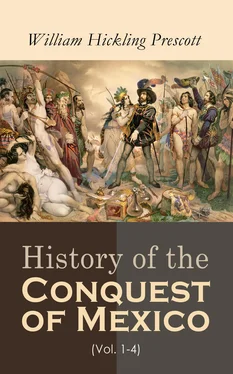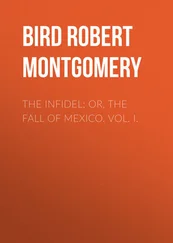The judges of the higher tribunals were maintained from the produce of a part of the crown lands, reserved for this purpose. They, as well as the supreme judge, held their offices for life. The proceedings in the courts were conducted with decency and order. The judges wore an appropriate dress, and attended to business both parts of the day, dining always, for the sake of despatch, in an apartment of the same building where they held their session; a method of proceeding much commended by the Spanish chroniclers, to whom despatch was not very familiar in their own tribunals. Officers attended to preserve order, and others summoned the parties and produced them in court. No counsel was employed; the parties stated their own case and supported it by their witnesses. The oath of the accused was also admitted in evidence. [62]The statement of the case, the testimony, and the proceedings of the trial were all set forth by a clerk, in hieroglyphical paintings, and handed over to the court. The paintings were executed with so much accuracy that in all suits respecting real property they were allowed to be produced as good authority in the Spanish tribunals, very long after the Conquest; and a chair for their study and interpretation was established at Mexico in 1553, which has long since shared the fate of most other provisions for learning in that unfortunate country. [63]
A capital sentence was indicated by a line traced with an arrow across the portrait of the accused. In Tezcuco, where the king presided in the court, this, according to the national chronicler, was done with extraordinary parade. His description, which is of rather a poetical cast, I give in his own words. “In the royal palace of Tezcuco was a court-yard, on the opposite sides of which were two halls of justice. In the principal one, called the ‘tribunal of God,’ was a throne of pure gold, inlaid with turquoises and other precious stones. On a stool in front was placed a human skull, crowned with an immense emerald of a pyramidal form, and surmounted by an aigrette of brilliant plumes and precious stones. The skull was laid on a heap of military weapons, shields, quivers, bows, and arrows. The walls were hung with tapestry, made of the hair of different wild animals, of rich and various colors, festooned by gold rings and embroidered with figures of birds and flowers. Above the throne was a canopy of variegated plumage, from the centre of which shot forth resplendent rays of gold and jewels. The other tribunal, called ‘the King’s,’ was also surmounted by a gorgeous canopy of feathers, on which were emblazoned the royal arms. Here the sovereign gave public audience and communicated his despatches. But when he decided important causes, or confirmed a capital sentence, he passed to the ‘tribunal of God,’ attended by the fourteen great lords of the realm, marshalled according to their rank. Then, putting on his mitred crown, incrusted with precious stones, and holding a golden arrow, by way of sceptre, in his left hand, he laid his right upon the skull, and pronounced judgment.” [64]All this looks rather fine for a court of justice, it must be owned. But it is certain that the Tezcucans, as we shall see hereafter, possessed both the materials and the skill requisite to work them up in this manner. Had they been a little further advanced in refinement, one might well doubt their having the bad taste to do so.
The laws of the Aztecs were registered, and exhibited to the people, in their hieroglyphical paintings. Much the larger part of them, as in every nation imperfectly civilized, relates rather to the security of persons than of property. [65]The great crimes against society were all made capital. Even the murder of a slave was punished with death. Adulterers, as among the Jews, were stoned to death. Thieving, according to the degree of the offence, was punished by slavery or death. Yet the Mexicans could have been under no great apprehension of this crime, since the entrances to their dwellings were not secured by bolts or fastenings of any kind. It was a capital offence to remove the boundaries of another’s lands; to alter the established measures; and for a guardian not to be able to give a good account of his ward’s property. These regulations evince a regard for equity in dealings, and for private rights, which argues a considerable progress in civilization. Prodigals, who squandered their patrimony, were punished in like manner; a severe sentence, since the crime brought its adequate punishment along with it. Intemperance, which was the burden, moreover, of their religious homilies, was visited with the severest penalties; as if they had foreseen in it the consuming canker of their own as well as of the other Indian races in later times. It was punished in the young with death, and in older persons with loss of rank and confiscation of property. Yet a decent conviviality was not meant to be proscribed at their festivals, and they possessed the means of indulging it, in a mild fermented liquor, called pulque , which is still popular, not only with the Indian, but the European population of the country. [66]
The rites of marriage were celebrated with as much formality as in any Christian country; and the institution was held in such reverence that a tribunal was instituted for the sole purpose of determining questions relating to it. Divorces could not be obtained until authorized by a sentence of this court, after a patient hearing of the parties.
But the most remarkable part of the Aztec code was that relating to slavery. There were several descriptions of slaves: prisoners taken in war, who were almost always reserved for the dreadful doom of sacrifice; criminals, public debtors, persons who, from extreme poverty, voluntarily resigned their freedom, and children who were sold by their own parents. In the last instance, usually occasioned also by poverty, it was common for the parents, with the master’s consent, to substitute others of their children successively, as they grew up; thus distributing the burden as equally as possible among the different members of the family. The willingness of freemen to incur the penalties of this condition is explained by the mild form in which it existed. The contract of sale was executed in the presence of at least four witnesses. The services to be exacted were limited with great precision. The slave was allowed to have his own family, to hold property, and even other slaves. His children were free. No one could be born to slavery in Mexico; [67]an honorable distinction, not known, I believe, in any civilized community where slavery has been sanctioned. [68]Slaves were not sold by their masters, unless when these were driven to it by poverty. They were often liberated by them at their death, and sometimes, as there was no natural repugnance founded on difference of blood and race, were married to them. Yet a refractory or vicious slave might be led into the market, with a collar round his neck, [69]which intimated his bad character, and there be publicly sold, and, on a second sale, reserved for sacrifice. [70]
Such are some of the most striking features of the Aztec code, to which the Tezcucan bore great resemblance. [71]With some exceptions, it is stamped with the severity, the ferocity indeed, of a rude people, hardened by familiarity with scenes of blood, and relying on physical instead of moral means for the correction of evil. [72]Still, it evinces a profound respect for the great principles of morality, and as clear a perception of these principles as is to be found in the most cultivated nations.
The royal revenues were derived from various sources. The crown lands, [73]which appear to have been extensive, made their returns in kind. The places in the neighborhood of the capital were bound to supply workmen and materials for building the king’s palaces and keeping them in repair. They were also to furnish fuel, provisions, and whatever was necessary for his ordinary domestic expenditure, which was certainly on no stinted scale. [74]The principal cities, which had numerous villages and a large territory dependent on them, were distributed into districts, with each a share of the lands allotted to it, for its support. The inhabitants paid a stipulated part of the produce to the crown. The vassals of the great chiefs, also, paid a portion of their earnings into the public treasury; an arrangement not at all in the spirit of the feudal institutions. [75]
Читать дальше












